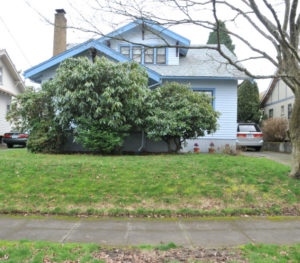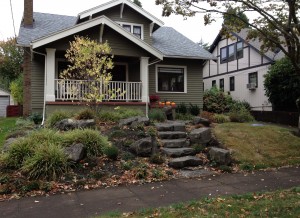
Bright blue Navel Wort – Omphaloides cappadocia ‘Cherry Ingram’ graces this dry stacked boulder wall in NW Portlands’ Willamette Heights. Clients love this plant!
Boulders create opportunity in Portland landscape designs.
As a Portland landscape designer I love boulders. They are so versatile and especially helpful with complex small urban properties. New construction properties in the city are always on difficult lots now unless they are a tear down. The lots are either very narrow, an unusual shape or steep. The easy lots were built on years ago. They are a good challenge for experienced designers. Clients are often completely baffled about their options.
Usable space
One of the big issues with these properties is creating usable space for my clients. A pretty landscape that can’t be used for entertaining even 4 adults is not functional in my opinion. Boulders help the designer create level, functional and usable areas. Boulders also bring nature into urban environments and add visual drama to the views from the home. A well placed boulder brings a sigh of relief to me, it’s hard to explain but I think it is the touch of nature that I feel.

I loved directing the boulder placement and designing the stairs for this Willamette Heights home in NW Portland.
Boulders retain the hillsides to allow the designer to carve out interesting walkways, stairs and planting areas above them. The spaces between the boulders create planting pockets which when thoughtfully planted result in layers of softening greenery. Planting the pockets creates another way to balance the proportions of hard surface to plant material. I love being able to use plants that are fussy about drainage in boulder crevices that I cannot use without copious soil preparation in flat properties. The bonus of being able to stand and tend the low maintenance plantings cannot be praised enough as my older clients will attest to.

This water feature with a large drilled Montana Mud boulder has a dry return so it is safe for a front yard with no child proof fence.
Water
Boulders and water are natural partners and I love to create simple low-maintenance water features using drilled rock and echo chambers. It’s an easy way to offset traffic noise and provides water for birds, bees and possibly your dog too. With a dry return instead of a high maintenance pond there is no mud so Fido won’t get to roll in the mud and bring it in to share w your sofa or carpet.
Proportional curb appeal
When the front yard is small we need strong visual impact to offset tall facades and large driveways. There is little plantable space and often the maximum hardscape allowed by the city or county. We need to be visually bold to offset this situation. Raising the soil with a few well placed boulders and adding complementary dramatic plant material can give us the impact we need.

Japanese Maple – Acer Palmatum ‘Shindeshojo’ in Westmoreland neighborhood SE Portland Landscape Design in a Day.
Boulders solve soil problems
Here’s an example….Planting a hot colored foliage Japanese maples up in a boulder planter create excellent drainage and helps avoid the dreaded verticillium wilt which is a good example of solving multiple problems with one solution. Flat lots with heavy clay soil can severely limit the selection of plant material that will survive. Supporting the raised soil with boulders gives me a wider selection of plants that will thrive without fuss. It’s not as easy to be dramatic with a limited plant palette.

NW Native Sword fern – Polystichum munitum has upright fronds in sun and horizontal low fronds in shade.
NW Natural Style
Boulders work beautifully with nw natural landscape style but it is easy to use them in modern landscape design too. The caricature of modern design can be harsh, bleak and boring. Paths, patios, entries and retaining walls must be carefully shaped and proportioned. Boulders bring in the relief of nature made versus man made and create an inviting atmosphere.
Read more about hillside landscape design.











